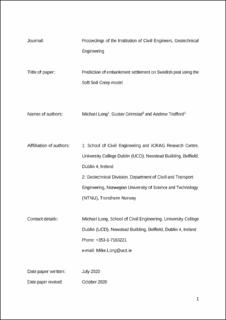| dc.contributor.author | Long, Michael | |
| dc.contributor.author | Grimstad, Gustav | |
| dc.contributor.author | Trafford, Andrew | |
| dc.date.accessioned | 2021-02-04T08:29:30Z | |
| dc.date.available | 2021-02-04T08:29:30Z | |
| dc.date.created | 2020-12-09T09:44:46Z | |
| dc.date.issued | 2020 | |
| dc.identifier.issn | 1353-2618 | |
| dc.identifier.uri | https://hdl.handle.net/11250/2726081 | |
| dc.description.abstract | Despite the prevalence of peat in northern areas of Europe and elsewhere, there are comparatively few case histories of carefully monitored embankments constructed directly on peat. In addition the use of relatively advanced and commercially available numerical models for prediction of the settlement in peat has only infrequently been documented. Practising geotechnical engineers lack advice on the use of such models and in particular on the selection of the input parameters. This paper demonstrates that a combination of routine oedometer tests, careful use of published correlations and simulations of independent data can provide reliable input parameters. The work demonstrates a good match between field measurements and simulations, but shows that it is difficult to model all stages of loading accurately with one set of input parameters. The user may need to focus on what specific output is critical and a number of analyses may be needed to obtain accurate prediction for all cases. Although the focus of the model used was on creep prediction, the work demonstrates that other benefits of using a finite-element analysis over hand calculations – such as modelling layers, buoyancy, variation in parameters such as permeability with strain and time – are perhaps more important than creep. | en_US |
| dc.language.iso | eng | en_US |
| dc.publisher | ICE Publishing | en_US |
| dc.title | Prediction of embankment settlement on Swedish peat using the soft soil creep model | en_US |
| dc.type | Peer reviewed | en_US |
| dc.type | Journal article | en_US |
| dc.description.version | acceptedVersion | en_US |
| dc.subject.nsi | VDP::Geoteknikk: 513 | en_US |
| dc.subject.nsi | VDP::Geological engineering: 513 | en_US |
| dc.source.journal | Proceedings of the Institution of Civil Engineers : Geotechnical Engineering | en_US |
| dc.identifier.doi | 10.1680/jgeen.20.00141 | |
| dc.identifier.cristin | 1857775 | |
| dc.description.localcode | © 2020. This is the authors’ accepted and refereed manuscript to the article. Locked until 16.12.2021 due to copyright restrictions. | en_US |
| cristin.ispublished | true | |
| cristin.fulltext | postprint | |
| cristin.qualitycode | 1 | |
